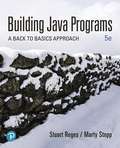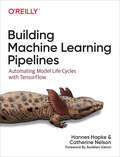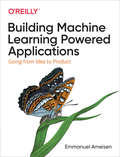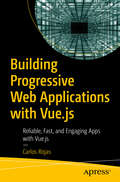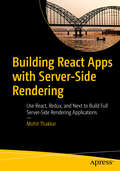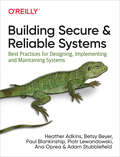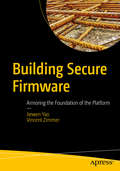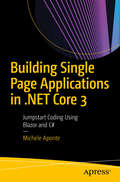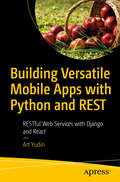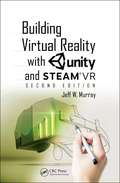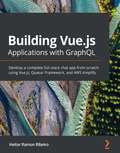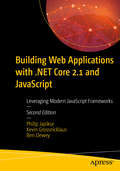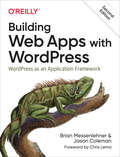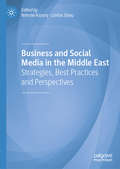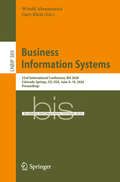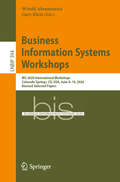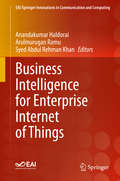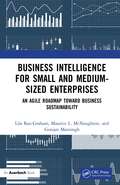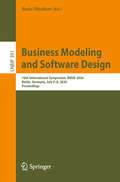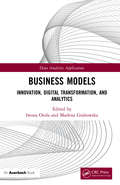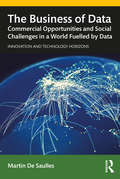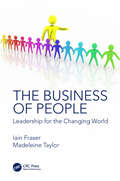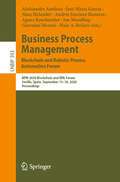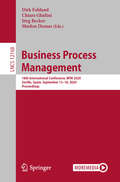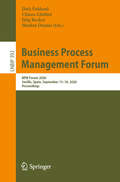- Table View
- List View
Building Java Programs: A Back To Basics Approach
by Stuart Reges Marty SteppEffective step-by-step Java education Building Java Programs: A Back to Basics Approach introduces new concepts and syntax using a spiral approach, ensuring students are thoroughly prepared as they work through CS1 material. Through the first four editions, Building Java Programs and its back-to-basics approach have proven remarkably effective. The 5th Edition has been extensively updated with incorporation of JShell integration, improved loop coverage, rewritten and revised case studies, examples, updated collection syntax and idioms, expanded self-check and programming exercising sections, and new programming projects.
Building Machine Learning Pipelines: Automating Model Life Cycles With Tensorflow
by Hannes Hapke Catherine NelsonCompanies are spending billions on machine learning projects, but it’s money wasted if the models can’t be deployed effectively. In this practical guide, Hannes Hapke and Catherine Nelson walk you through the steps of automating a machine learning pipeline using the TensorFlow ecosystem. You’ll learn the techniques and tools that will cut deployment time from days to minutes, so that you can focus on developing new models rather than maintaining legacy systems.Data scientists, machine learning engineers, and DevOps engineers will discover how to go beyond model development to successfully productize their data science projects, while managers will better understand the role they play in helping to accelerate these projects.Understand the steps to build a machine learning pipelineBuild your pipeline using components from TensorFlow ExtendedOrchestrate your machine learning pipeline with Apache Beam, Apache Airflow, and Kubeflow PipelinesWork with data using TensorFlow Data Validation and TensorFlow TransformAnalyze a model in detail using TensorFlow Model AnalysisExamine fairness and bias in your model performanceDeploy models with TensorFlow Serving or TensorFlow Lite for mobile devicesLearn privacy-preserving machine learning techniques
Building Machine Learning Powered Applications: Going from Idea to Product
by Emmanuel AmeisenLearn the skills necessary to design, build, and deploy applications powered by machine learning (ML). Through the course of this hands-on book, you’ll build an example ML-driven application from initial idea to deployed product. Data scientists, software engineers, and product managers—including experienced practitioners and novices alike—will learn the tools, best practices, and challenges involved in building a real-world ML application step by step.Author Emmanuel Ameisen, an experienced data scientist who led an AI education program, demonstrates practical ML concepts using code snippets, illustrations, screenshots, and interviews with industry leaders. Part I teaches you how to plan an ML application and measure success. Part II explains how to build a working ML model. Part III demonstrates ways to improve the model until it fulfills your original vision. Part IV covers deployment and monitoring strategies.This book will help you:Define your product goal and set up a machine learning problemBuild your first end-to-end pipeline quickly and acquire an initial datasetTrain and evaluate your ML models and address performance bottlenecksDeploy and monitor your models in a production environment
Building Progressive Web Applications with Vue.js: Reliable, Fast, and Engaging Apps with Vue.js
by Carlos RojasObtain all the necessary tools for developing a progressive web application (PWA) with Vue.js, a modern JavaScript framework. You’ll see how PWAs behave like a regular responsive website and have a similar structure to that of a web application, but feel like a native mobile app. Along the way you’ll take advantage of Vue.js features to build fast, high-performing progressive web apps that work offline. Building Progressive Web Applications with Vue.js starts by explaining the basic concepts and structure of PWAs, and moves on to designing the app shell and other features that distinguish a PWA from simple web pages. In the following chapters, the book talks about the improved web technologies, such as service workers, caching strategies, background sync, and push notifications, that make PWAs powerful.What You Will LearnHarness the power of Vue.js to build PWAs Understand the function and relevance of a manifest fileDiscover service workers and why they are revolutionaryWork with the Cache API and caching strategiesUse IndexedDB, background sync, and push notificationsEnhance your apps with FirebaseImplement the Workbox library in your appsWho This Book Is ForWeb developers who want to venture into building PWAs would find the book useful.
Building React Apps with Server-Side Rendering: Use React, Redux, and Next to Build Full Server-Side Rendering Applications
by Mohit ThakkarLeverage the benefits of both client-side and server-side rendering to get the most out of your React applications. By the end of this book you will be able to build and deploy React applications using the Next.js framework to fully render server-side HTML on every Web page. You'll begin by reviewing JavaScript fundamentals and how they work with the core principles of React. You'll then move on to Next.js, the React framework for server-rendered applications. Using this framework, you will create a fast and secure solutional React application that renders content on the server-side, protects sensitive information, and optimizes response times. Before deploying the application using Docker containers, you'll create automated unit tests to verify that every component is appropriately doing its jobBuilding React Apps with Server-Side Rendering also covers other fun and interesting topics such as Bootstrap 4, JSX (JavaScript XML), adding styling to your React applications, and much more. By the end of this book, you will be able to build and deploy React applications that fully render server-side HTML on every page. In the end you'll have a client-side rendered React application that integrates server-side rendering into it using Next.js framework. What You'll Learn Examine fundamental concepts of JavaScript (ES 2015)Create client-side apps using JavaScript frameworks React and ReduxAdd server-side rendering to React apps using the NextJS Framework Who This Book Is For Web developers who have prior experience in working with JavaScript, HTML and CSS, who wish to step up a level and create better web applications using modern JavaScript frameworks like React, Reduct & Next.
Building Secure and Reliable Systems: Best Practices for Designing, Implementing, and Maintaining Systems
by Heather Adkins Betsy Beyer Paul Blankinship Piotr Lewandowski Ana Oprea Adam StubblefieldCan a system be considered truly reliable if it isn't fundamentally secure? Or can it be considered secure if it's unreliable? Security is crucial to the design and operation of scalable systems in production, as it plays an important part in product quality, performance, and availability. In this book, experts from Google share best practices to help your organization design scalable and reliable systems that are fundamentally secure. <P><P>Two previous O’Reilly books from Google—Site Reliability Engineering and The Site Reliability Workbook—demonstrated how and why a commitment to the entire service lifecycle enables organizations to successfully build, deploy, monitor, and maintain software systems. In this latest guide, the authors offer insights into system design, implementation, and maintenance from practitioners who specialize in security and reliability. They also discuss how building and adopting their recommended best practices requires a culture that’s supportive of such change. <P><P>You’ll learn about secure and reliable systems through: <P><P>Design strategies <P><P>Recommendations for coding, testing, and debugging practices <P><P>Strategies to prepare for, respond to, and recover from incidents <P><P>Cultural best practices that help teams across your organization collaborate effectively
Building Secure Firmware: Armoring the Foundation of the Platform
by Jiewen Yao Vincent ZimmerUse this book to build secure firmware.As operating systems and hypervisors have become successively more hardened, malware has moved further down the stack and into firmware. Firmware represents the boundary between hardware and software, and given its persistence, mutability, and opaqueness to today’s antivirus scanning technology, it represents an interesting target for attackers.As platforms are universally network-connected and can contain multiple devices with firmware, and a global supply chain feeds into platform firmware, assurance is critical for consumers, IT enterprises, and governments. This importance is highlighted by emergent requirements such as NIST SP800-193 for firmware resilience and NIST SP800-155 for firmware measurement. This book covers the secure implementation of various aspects of firmware, including standards-based firmware—such as support of the Trusted Computing Group (TCG), Desktop Management Task Force (DMTF), and Unified Extensible Firmware Interface (UEFI) specifications—and also provides code samples and use cases. Beyond the standards, alternate firmware implementations such as ARM Trusted Firmware and other device firmware implementations (such as platform roots of trust), are covered. What You Will Learn Get an overview of proactive security development for firmware, including firmware threat modelingUnderstand the details of architecture, including protection, detection, recovery, integrity measurement, and access controlBe familiar with best practices for secure firmware development, including trusted execution environments, cryptography, and language-based defensesKnow the techniques used for security validation and maintenanceWho This Book Is ForGiven the complexity of modern platform boot requirements and the threat landscape, this book is relevant for readers spanning from IT decision makers to developers building firmware
Building Single Page Applications in .NET Core 3: Jumpstart Coding Using Blazor and C#
by Michele AponteAttention .NET developers who no longer want to use JavaScript for your front end. Quickly and efficiently learn how to use C# for your single-page application (SPA) thanks to Blazor. Today’s reality is that most modern applications are web-based and if you want the same user experience as a desktop application, you need to be able to create a single-page application. While there are multiple frameworks and libraries to choose from (including Angular, React, and VueJS), you still need to know how to code in JavaScript. But now there is another option from Microsoft. Blazor is an open-source framework that enables developers to create web applications using C# and HTML, and everything you need to get started is covered in this guide. You will learn the steps, through build-along coding examples, that will allow you to use the same language for both the front end and the back end of your application. This book is designed to get you comfortable creating a single-page application in the shortest time possible. Get ready to create a complete business application that teaches and reinforces the skills you need in a Blazor production environment.What You Will Learn Develop the front end of an application using C# and .NET Core Use this quick-start for .NET developers who need to improve their application with a single-page front end Take a code-first approach that models an actual business application Gain insights for developing a high-functioning and maintainable applicationStudy guidance on repurposing your .NET skill setWho This Book Is ForC# and .NET developers who have some experience in web development
Building Versatile Mobile Apps with Python and REST: RESTful Web Services with Django and React
by Art YudinDevelop versatile iOS apps using Python with RESTful web services. This book will show you how to blend Django, a high-level Python Web framework, with Django REST, the powerful, feature-filled extension, to build iOS mobile apps.Using easy-to-follow examples, you'll begin by building a simple app using the RESTful Web API and iOS. You'll begin by using traditional Django to create models and connect your App to the database. You'll then see how to serialize your data and create the RESTful API. The second part of the book introduces Xcode, a programming environment to develop iOS apps. Using Swift, the programming language for iOS, you'll design the actual app. Once you have your back-end in Django and a front-end in Swift, you'll connect them using our RESTful API. You'll be able to log in, browse places of interest, and rate them and leave comments. Guided step-by-step instructions, Building Versatile Mobile Apps with Python and REST will demonstrate how easy it is to use Python to develop iOS applications. What You'll LearnBuild Create-Read-Update-Delete functionality using RESTful Web Services Incorporate marketing into the design of iOS apps to stand out in the App Store Deploy your app to a live server and add it to Apple app store Who This Book Is ForAspiring programmers who want to develop modern RESTful Web Services and design the front-end for iOS. Developers who want to combine the most powerful and popular back-end technology—Python—and monetize it with a popular iOS platform in Apple App Store.
Building Virtual Reality with Unity and SteamVR
by Jeff W MurrayBuilding Virtual Reality with Unity and Steam VR takes a hands-on approach to getting up and running with virtual reality using the Unity game engine. By utilizing the free SteamVR 2.x libraries, this book and its example code are compatible with the main virtual reality (VR) head-mounted displays currently available. This book also looks at some of the main issues surrounding virtual reality, such as motion sickness and performance issues, providing practical ways to reduce their impact to make better VR experiences. Key Features: Discusses some of the key issues facing virtual reality and provides helpful tips for making better VR experiences Practical examples geared to work with any headset compatible with SteamVR, including Oculus Rift, HTC Vive, and Valve Index Uses the SteamVR Interaction system for interactions such as picking up and throwing objects, operating user interfaces and capturing input events for your own scripts Explore advanced spatialized audio with Steam Audio. Discover how to build user interfaces for virtual reality, as well as discussing some best practices for VR-based user interface design Written by a games industry veteran with a proven track record, having worked for IBM Research in educational VR research projects and having made and launched VR experiences.
Building Vue.js Applications with GraphQL: Develop a complete full-stack chat app from scratch using Vue.js, Quasar Framework, and AWS Amplify
by Heitor Ramon RibeiroTake your Vue.js knowledge to the next level by understanding full-stack development concepts and exploring modern web technologies such as AWS Amplify, GraphQL, and Quasar FrameworkKey FeaturesBuild a fully functional Vue.js web app and learn how it integrates with GraphQLTransform your chat application into a Progressive Web Application (PWA) for web deploymentDiscover practical recipes, exploring the capabilities of the GraphQL API for full-stack development using Quasar FrameworkBook DescriptionSince its release by Facebook in 2012, GraphQL has taken the internet by storm. Huge companies such as Airbnb and Audi have started to adopt it, while small to medium-sized companies are now recognizing the potential of this query-based API. GraphQL may seem strange at first, but as you start to read about and experience more of it, you won't want to use REST APIs anymore. With the recipes in this book, you will learn how to build a complete real-time chat app from scratch. Starting by creating an AWS Amplify environment, you will delve into developing your first GraphQL Schema. You will then learn how to add the AppSync GraphQL client and create your first GraphQL mutation. The book also helps you to discover the simplicity and data fetching capabilities of GraphQL that make it easy for front-end developers to communicate with the server. You will later understand how to use Quasar Framework to create application components and layouts. Finally, you will find out how to create Vuex modules in your application to manage the app state, fetch data using the GraphQL client, and deploy your application to the web. By the end of this book, you'll be well versed in proof-of-concept full-stack applications that explore the power of GraphQL with AWS Amplify, and you'll be able to use Quasar Framework to create your Vue applications.What you will learnSet up your Vue.js projects with Vue CLI and explore the power of Vue componentsDiscover steps to create functional components in Vue.js for faster renderingBecome familiar with AWS Amplify and learn how to set up your environmentUnderstand how to create your first GraphQL schemaUse Quasar Framework to create simple and effective interfacesDiscover effective techniques to create queries for interacting with dataExplore Vuex for adding state management capabilities to your appDiscover techniques to deploy your applications effectively to the webWho this book is forThis book is for intermediate-level Vue.js developers who want to take their first step toward full-stack development. Prior knowledge of Vue.js and JavaScript is required before getting started with this book.
Building Web Applications with .NET Core 2.1 and JavaScript: Leveraging Modern JavaScript Frameworks
by Philip Japikse Kevin Grossnicklaus Ben DeweyRoll up your sleeves and jump into building web applications using .NET Core 2.1 and the most popular JavaScript frameworks.You will start by building a data access layer using Entity Framework Core, a RESTful service using ASP.NET Core, and then you will build a web application following the MVC pattern, also using ASP.NET Core. The resulting application is an example e-commerce site using the most appropriate capabilities in .NET Core for building a line of business applications.The second half of Building Web Applications with .NET Core 2.1 and JavaScript is dedicated to teaching you how to develop applications on the client with JavaScript, BootStrap, and related tooling such as TypeScript, WebPack, NPM, and more. Each JavaScript framework will build the same UI as the ASP.NET Core web application from the first half of the book, leveraging the same ASP.NET Core RESTful service and Entity Framework Core data access layer. Building the same UI in the different JavaScript frameworks provides the context and knowledge to reasonably compare and contrast the tools. What You Will Learn Ramp up quickly on Entity Framework Core and ASP.NET CoreUse TypeScript to deliver better JavaScriptManage your JavaScript build processKnow how to build UIs with ASP.NET Core MVC, Angular, and React to make better decisions on which technologies to adopt in your projectsConduct an apples-to-apples comparison of ASP.NET Core, Angular, and React Who This Book Is For .NET architects, consultants, and developers who want to modernize their skill set. Some understanding of JavaScript and the Web is useful.
Building Web Apps with WordPress: WordPress as an Application Framework
by Brian Messenlehner Jason ColemanWordPress is much more than a blogging platform. If you have basic PHP, HTML, CSS, and JavaScript experience you can use WordPress to develop fast, scalable, secure, and highly customized web apps, mobile apps, web services, and multisite networks of websites. Along with core WordPress functions and database schema, you’ll learn how to build custom plugins, themes, and services for just about any kind of web or mobile application.In this updated second edition, Brian Messenlehner and Jason Coleman cover new features and functionality added to WordPress up to version 5.4. All code examples in the book are available on GitHub.Compare WordPress with traditional app development frameworksUse themes for views and plugins for backend functionalityGet suggestions for choosing or building WordPress pluginsRegister custom post types (CPTs) and taxonomiesManage user accounts and roles, and access user dataBuild asynchronous behaviors with jQueryUse WordPress to develop mobile apps for iOS and AndroidIntegrate PHP libraries, external APIs, and web service pluginsCollect payments through ecommerce and membership pluginsLearn how to speed up and scale your WordPress appExtend the WordPress REST API and create custom endpointsLearn about WordPress Gutenberg blocks development
Business and Social Media in the Middle East: Strategies, Best Practices and Perspectives
by Nehme Azoury Lindos DaouThis book discusses the effectiveness of Western organizations’ social media strategies in the Middle East. Social media has changed the rules of doing business, but the exact impacts vary across regions. In the context of Middle Eastern societies, social media is seen as a way for individuals and communities to communicate with each other and is generally not viewed as a means for brands to interact with individuals. Examining how the use of social media in the Middle East is shaped by the region’s culture, authors discuss the factors that businesses need to consider when creating digital marketing strategies targeted there. Including case studies of Middle Eastern companies, this book provides a comprehensive analysis of the rise of social media in the MENA region and the often-neglected role of culture in research in this area. It will provide researchers and practitioners with a deeper understanding of conducting business in the Middle East through the effective and efficient use of social media.
Business Information Systems: 23rd International Conference, BIS 2020, Colorado Springs, CO, USA, June 8–10, 2020, Proceedings (Lecture Notes in Business Information Processing #389)
by Witold Abramowicz Gary KleinThis book constitutes the proceedings of the 23rd International Conference on Business Information Systems, BIS 2020, which was planned to take place in Colorado Springs, CO, USA. Due to the COVID-19 pandemic, the conference was held fully online during June 8–10, 2020. This year's theme was "Data Science and Security in Business Information Systems". The 30 contributions presented in this volume were carefully reviewed and selected from 86 submissions. The book also contains two contributions from BIS 2019. The papers were organized in the following topical sections: Data Security, Big Data and Data Science, Artificial Intelligence, ICT Project Management, Applications, Social Media, Smart Infrastructures.
Business Information Systems Workshops: BIS 2020 International Workshops, Colorado Springs, CO, USA, June 8–10, 2020, Revised Selected Papers (Lecture Notes in Business Information Processing #394)
by Witold Abramowicz Gary KleinThis book constitutes revised papers from the five workshops which were held during June 2020 at the 23rd International Conference on Business Information Systems, BIS 2020. The conference was planned to take place in Colorado Springs, CO, USA. Due to the COVID-19 pandemic it changed to a virtual format. There was a total of 54 submissions to all workshops of which 26 papers were accepted for publication. The workshops included in this volume are: BITA 2020: 11th Workshop on Business and IT Alignment BSCT 2020: 3rd Workshop on Blockchain and Smart Contract Technologies DigEX 2020: 2nd International Workshop on transforming the Digital Customer Experience iCRM 2020: 5th International Workshop on Intelligent Data Analysis in Integrated Social CRM QOD 2020: 3rd Workshop on Quality of Open Data
Business Intelligence for Enterprise Internet of Things (EAI/Springer Innovations in Communication and Computing)
by Anandakumar Haldorai Arulmurugan Ramu Syed Abdul Rehman KhanThis book discusses Internet of Things (IoT) as it relates to enterprise applications, systems, and infrastructures. The authors discuss IoT and how it’s disrupting industries such as enterprise manufacturing, enterprise transportation, enterprise smart market, enterprise utilities, and enterprise healthcare. They cover how IoT in the enterprise will have a major impact on the lives of consumers and professionals around the world and how it will change the way we think about professional and consumer networks. The book's topics include IoT enterprise system architecture, IoT enabling enterprise technologies, and IoT enterprise services and applications. Examples include enterprise on demand, market impacts, and implications on smart technologies, big data enterprise management, and future enterprise Internet design for various IoT use cases, such as share markets, healthcare, smart cities, smart environments, smart communications and smart homes.
Business Intelligence for Small and Medium-Sized Enterprises: An Agile Roadmap toward Business Sustainability
by Lila Rao-Graham Maurice L. McNaughton Gunjan MansinghBusiness intelligence (BI) has evolved over several years as organizations have extended their online transaction processing (OLTP) capabilities and applications to support their routine operations. With online analytical processing (OLAP), organizations have also established the capability to extract internal and external data from a variety of sources to specifically obtain intelligence about non-routine and often less-structured arrangements. BI therefore refers to applications and technologies that are used to gather, provide access to, and analyze data and information about the operations of an organization. It has the capability of providing comprehensive insight into the more volatile factors affecting the business and its operations, thereby facilitating enhanced decision-making quality and contributing to the creation of business value. Larger and more sophisticated organizations have long been exploiting these capabilities. Business Intelligence for Small and Medium-Sized Enterprises (SMEs) guides SMEs in replicating this experience to provide an agile roadmap toward business sustainability. The book points out that successful BI implementations have generated significant increases in revenue and cost savings, however, the failure rates are also very high. More importantly, it emphasizes that a full range of BI capabilities is not the exclusive purview of large organizations. It shows how SMEs make extensive use of BI techniques to develop the kind of agility endowing them with the organizational capability to sense and respond to opportunities and threats in an increasingly dynamic business environment. It points to the way to a market environment in which smaller organizations could have a larger role. In particular, the book explains that by establishing the agility to leverage internal and external data and information assets, SMEs can enhance their competitiveness by having a comprehensive understanding of the key to an agile roadmap for business sustainability.
Business Modeling and Software Design: 10th International Symposium, BMSD 2020, Berlin, Germany, July 6-8, 2020, Proceedings (Lecture Notes in Business Information Processing #391)
by Boris ShishkovThis book constitutes the refereed proceedings of the 10th International Symposium on Business Modeling and Software Design, BMSD 2020, which took place in Berlin, Germany, in July 2020. BMSD is a leading international forum that brings together researchers and practitioners interested in business modeling and its relation to software design. Particular areas of interest are: Business Processes and Enterprise Engineering; Business Models and Requirements; Business Models and Services; Business Models and Software; Information Systems Architectures and Paradigms; Data Aspects in Business Modeling and Software Development; Blockchain-Based Business Models and Information Systems; IoT and Implications for Enterprise Information Systems. The theme of BMSD 2020 was: Towards Knowledge-Driven Enterprise Information Systems.
Business Models: Innovation, Digital Transformation, and Analytics (Data Analytics Applications)
by Iwona Otola Marlena GrabowskaSince the beginning of time, running a business has involved using logic by which the business operates. This logic is called the business model in management science, which increasingly is focusing on issues surrounding business models. Research trends related to business models include value creation, value chain operationalization, and social and ecological aspects, as well as innovation and digital transformation. Business Models: Innovation, Digital Transformation, and Analytics examines how innovation, digital transformation, and the composition of value affect the existence and development of business models. The book starts by addressing the conceptual development of business models and by discussing the essence of innovation in those models. Chapters in the book investigate how: Business models can analyze digital transformation scenarios Individual business model elements effect selected performance measures as well as how the elements are significant for the enterprise value composition The environment effects the profitability of the high-growth enterprise business models Employer branding business models are perceived by the generation Z workforce To implement responsible business models in the enterprise Cyber risk is captured in business models Decision algorithms are important to business analytics This book is a compendium of knowledge about the use of business models in the context of innovative activities, digital transformation, and value composition. It attempts to combine the theory and practice and offers a look at business models currently used in companies, especially high-growth enterprises, in various countries of the world and indicates the prospects for their development.
The Business of Data: Commercial Opportunities and Social Challenges in a World Fuelled by Data (Innovation and Technology Horizons)
by Martin De SaullesThis book is about the rise of data as a driver of innovation and economic growth. It charts the evolution of business data as a valuable resource and explores some of the key business, economic and social issues surrounding the data-driven revolution we are currently going through. Readers will gain an understanding of the historical underpinnings of the data business and why the collection and use of data has been driven by commercial needs. Readers will also gain insights into the rise of the modern data-driven technology giants, their business models and the reasons for their success. Alongside this, some of the key social issues including privacy are considered and the challenges these pose to policymakers and regulators. Finally, the impact of pervasive computing and the Internet of Things (IoT) is explored in the context of the new sources of data that are being generated. This book is useful for students and practitioners wanting to better understand the origins and drivers of the current technological revolution and the key role that data plays in innovation and business success.
The Business of People: Leadership for the Changing World
by Iain Fraser Madeleine TaylorThe Business of People is purposefully focused on people. The book will assist you to develop and support yourself with your people leadership, knowledge, and skills. It is an opportunity to better manage yourself and lead others, including your organization, into the modern volatile, uncertain, complex, and ambiguous (VUCA) world. It is also a sequel to the top-selling book The Business of Portfolio Management: Boosting Organizational Value. Authors Madeleine Taylor and Iain Fraser combine to give you the very best in knowledge and experience in a variety of situations. This is a book that cuts through the nonsense and presents real-world solutions for situations facing leaders today and tomorrow. Shifting from managing people to leading people requires a pivot...Leadership matters because the future is at greater risk without it. Regardless of where you are in your leadership journey I am confident this new book from Madeleine and Iain will be a valuable resource for you. Enjoy the journey, it never ends. —Mark A. Langley, Former President and CEO, Project Management Institute Iain and Madeleine are honest and raw about the challenges faced, and the resiliency needed, to lead in business. —Suzanne M. O’Gorman, Senior Strategic Business Architect, United Healthcare Group In a world where leadership increasingly requires emotional and cultural intelligence skills, this masterpiece couldn’t be any timelier. —Dr. Hilary Aza, Senior Portfolio Manager, Tarrant County, Texas Essential for anyone seeking to better understand their personal leadership and to inform further development. —Rob Loader, Executive, Capital Planning & Delivery, Telstra Corporation The book to me is written from a position of empowerment, cultural acknowledgment, hopefulness, and purpose.—Elissa Farrow, Founder, About Your Transition This book will challenge your own thinking and behaviour and give you an opportunity to develop your adaptability and leadership style for an evolving future. —Thomas Davis, GM, Corporate Services, Capital & Coast District Health Board, New Zealand
Business Process Management: BPM 2020 Blockchain and RPA Forum, Seville, Spain, September 13–18, 2020, Proceedings (Lecture Notes in Business Information Processing #393)
by Aleksandre Asatiani José María García Nina Helander Andrés Jiménez-Ramírez Agnes Koschmider Jan Mendling Giovanni Meroni Hajo A. ReijersThis book constitutes the proceedings of the Blockchain and Robotic Process Automation (RPA) Forum which was held as part of the 18th International Conference on Business Process Management, BPM 2020. The conference was planned to take place in Seville, Spain, in September 2020. Due to the COVID-19 pandemic the conference took place virtually.The Blockchain Forum and the RPA Forum have in common that they are centered around an emerging and exciting technology. The blockchain is a sophisticated distributed ledger technology, while RPA software allows for mimicking human, repetitive actions. Each of these have the potential to fundamentally change how business processes are being orchestrated and executed in practice. The BPM community has embraced these technologies as objects of analysis, design, development, and evaluation.The 14 full plus one short paper presented in this volume were carefully reviewed and selected from a total of 28 submissions.
Business Process Management: 18th International Conference, BPM 2020, Seville, Spain, September 13–18, 2020, Proceedings (Lecture Notes in Computer Science #12168)
by Dirk Fahland Chiara Ghidini Jörg Becker Marlon DumasThis book constitutes the proceedings of the 18th International Conference on Business Process Management, BPM 2020, held in Seville, Spain, in September 2020. The conference was held virtually due to the COVID-19 pandemic. The 27 full papers included in this volume were carefully reviewed and selected from 125 submissions. Two full keynote papers are also included. The papers are organized in topical sections named: foundations; engineering; and management.
Business Process Management Forum: BPM Forum 2020, Seville, Spain, September 13–18, 2020, Proceedings (Lecture Notes in Business Information Processing #392)
by Dirk Fahland Chiara Ghidini Jörg Becker Marlon DumasThis book constitutes the proceedings of the BPM Forum of the 18th International Conference on Business Process Management, BPM 2020, which was planned to take place in Seville, Spain, in September 2020. Due to the COVID-19 pandemic the conference took place virtually. The BPM Forum hosts innovative research which has a high potential of stimulating discussions. The papers selected for the forum are expected to showcase fresh ideas from exciting and emerging topics in BPM, even if they are not yet as mature as the regular papers at the conference. The 19 papers presented in this volume were carefully reviewed and selected from a total of 125 submissions to the main conference. They were organized in topical sections named: process modeling; process mining; predictions and recommendations; BPM adoption and maturity; and standardization, change, and handoffs.
